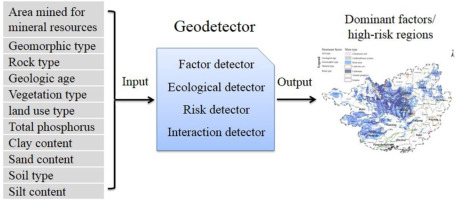当前位置:
X-MOL 学术
›
Environ. Pollut.
›
论文详情
Our official English website, www.x-mol.net, welcomes your
feedback! (Note: you will need to create a separate account there.)
Cadmium source identification in soils and high-risk regions predicted by geographical detector method.
Environmental Pollution ( IF 7.6 ) Pub Date : 2020-04-03 , DOI: 10.1016/j.envpol.2020.114338 Yinjun Zhao 1 , Qiyu Deng 2 , Qing Lin 1 , Changyu Zeng 2 , Cong Zhong 1
Environmental Pollution ( IF 7.6 ) Pub Date : 2020-04-03 , DOI: 10.1016/j.envpol.2020.114338 Yinjun Zhao 1 , Qiyu Deng 2 , Qing Lin 1 , Changyu Zeng 2 , Cong Zhong 1
Affiliation

|
Cadmium (Cd) contamination in soils has become a serious and widespread environmental problem, especially in areas with high natural background Cd values, but the mechanism of Cd enrichment in these areas is still unclear. This study uses the Guangxi Zhuang Autonomous Region (Guangxi), a typical area with a high background Cd level and Cd pollution related to mining activities, as an example to explore the source and predict areas with high Cd risk in soils based on the geographical detector method. The areas with high Cd in Guangxi soils were classified into non-mining areas and mining areas according to their potential Cd sources. The results show that the rich Cd content in the soils from the non-mining area of Guangxi was mainly derived from the soil type (q = 0.34), geological age (q = 0.27), rock type (q = 0.26) and geomorphic type (q = 0.20). Specifically, the Cd content was derived from the weathering and deposition processes of carbonatite from the Carboniferous system in the karst area. The high Cd content in the soils of the mining area of Guangxi was mainly derived from the area mined for mineral resources (q = 0.08) and rock type (q = 0.05). Specifically, the Cd content was derived from the mining of lead-zinc ores. The areas in Guangxi with a high risk of Cd soil pollution are mostly concentrated in karst areas, such as Hechi, Laibin, Chongzuo, southern Liuzhou and Baise, northern Nanning city and northeastern Guilin city, and some mining areas. These results indicated that the high Cd concentration in the soils of large areas of Guangxi is probably due to natural sources, while the high Cd concentration around mining areas is due to anthropogenic sources. The results will be useful for soil restoration and locating and controlling contaminated agricultural land.
中文翻译:

地理探测器法预测土壤和高风险地区的镉源识别。
土壤中的镉(Cd)污染已成为一个严重且普遍的环境问题,尤其是在具有高自然本底Cd值的地区,但这些地区Cd富集的机制仍不清楚。本研究以广西壮族自治区(广西)为例,该地区典型的背景Cd含量高和与采矿活动相关的Cd污染,以基于地理探测器的土壤为例,探索并预测了土壤中Cd高风险区域。方法。根据广西土壤中镉含量高的地区,根据其潜在的镉来源将其划分为非矿区和矿区。结果表明,广西非矿区土壤中丰富的镉含量主要来源于土壤类型(q = 0.34),地质年龄(q = 0.27),岩石类型(q = 0.26)和地貌类型。 (q = 0。20)。具体而言,Cd含量来自岩溶地区石炭系碳酸盐岩的风化和沉积过程。广西矿区土壤中的高Cd含量主要来自矿产资源开采面积(q = 0.08)和岩石类型(q = 0.05)。具体而言,Cd含量来自铅锌矿石的开采。广西镉土污染风险高的地区主要集中在河池,来宾,崇左,柳州和百色南部,南宁市北部和桂林市东北等喀斯特地区和一些矿区。这些结果表明,广西大面积土壤中的高Cd浓度可能是由于自然资源引起的,而矿区周围的高Cd浓度则是由于人为原因引起的。
更新日期:2020-04-06
中文翻译:

地理探测器法预测土壤和高风险地区的镉源识别。
土壤中的镉(Cd)污染已成为一个严重且普遍的环境问题,尤其是在具有高自然本底Cd值的地区,但这些地区Cd富集的机制仍不清楚。本研究以广西壮族自治区(广西)为例,该地区典型的背景Cd含量高和与采矿活动相关的Cd污染,以基于地理探测器的土壤为例,探索并预测了土壤中Cd高风险区域。方法。根据广西土壤中镉含量高的地区,根据其潜在的镉来源将其划分为非矿区和矿区。结果表明,广西非矿区土壤中丰富的镉含量主要来源于土壤类型(q = 0.34),地质年龄(q = 0.27),岩石类型(q = 0.26)和地貌类型。 (q = 0。20)。具体而言,Cd含量来自岩溶地区石炭系碳酸盐岩的风化和沉积过程。广西矿区土壤中的高Cd含量主要来自矿产资源开采面积(q = 0.08)和岩石类型(q = 0.05)。具体而言,Cd含量来自铅锌矿石的开采。广西镉土污染风险高的地区主要集中在河池,来宾,崇左,柳州和百色南部,南宁市北部和桂林市东北等喀斯特地区和一些矿区。这些结果表明,广西大面积土壤中的高Cd浓度可能是由于自然资源引起的,而矿区周围的高Cd浓度则是由于人为原因引起的。











































 京公网安备 11010802027423号
京公网安备 11010802027423号